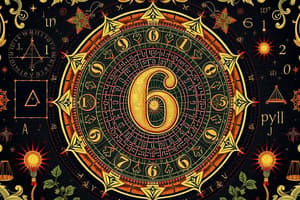Podcast
Questions and Answers
The number π is an example of an ______ number.
The number π is an example of an ______ number.
irrational
Letters or symbols representing unknown values are called ______.
Letters or symbols representing unknown values are called ______.
variables
A combination of variables, constants, and operations is called an ______.
A combination of variables, constants, and operations is called an ______.
expression
Statements with equal signs (=) are called ______.
Statements with equal signs (=) are called ______.
The set of numbers including all rational and irrational numbers is called ______.
The set of numbers including all rational and irrational numbers is called ______.
Flashcards are hidden until you start studying
Study Notes
Numbers
- Types of numbers:
- Natural numbers (1, 2, 3, ...)
- Whole numbers (0, 1, 2, 3, ...)
- Integers (...,-3, -2, -1, 0, 1, 2, 3, ...)
- Rational numbers (fractions, decimals)
- Irrational numbers (π, e, ...)
- Real numbers (all rational and irrational numbers)
- Complex numbers (with imaginary parts)
Algebra
- Variables and expressions:
- Variables: letters or symbols representing unknown values
- Expressions: combinations of variables, constants, and operations
- Equations and inequalities:
- Equations: statements with equal signs (=)
- Inequalities: statements with greater than (>), less than (<), etc.
- Functions:
- Domain: set of input values
- Range: set of output values
- Notation: f(x) = ...
Geometry
- Points, lines, and planes:
- Points: locations in space (x, y, z coordinates)
- Lines: sets of points extending infinitely in two directions
- Planes: flat surfaces extending infinitely in all directions
- Angles and measurements:
- Degrees: units of angle measurement
- Types of angles: acute, right, obtuse, straight, reflex
- Shapes and figures:
- 2D: triangles, quadrilaterals, polygons, circles
- 3D: pyramids, prisms, spheres, cones, cylinders
Calculus
- Limits:
- Concept of approaching a value
- Notation: lim x→a f(x) = ...
- Derivatives:
- Rate of change of a function
- Notation: f'(x) = ...
- Integrals:
- Accumulation of a function
- Notation: ∫f(x)dx = ...
Statistics and Probability
- Data analysis:
- Types of data: qualitative, quantitative
- Measures of central tendency: mean, median, mode
- Measures of variability: range, variance, standard deviation
- Probability:
- Events: outcomes of an experiment
- Probability measures: 0 to 1, or 0% to 100%
- Rules of probability: addition, multiplication, complement
Numbers
- Natural numbers are a set of positive integers starting from 1, such as 1, 2, 3, and so on.
- Whole numbers are a set of non-negative integers, including 0, such as 0, 1, 2, 3, and so on.
- Integers are a set of whole numbers and their negative counterparts, such as ..., -3, -2, -1, 0, 1, 2, 3, and so on.
- Rational numbers are fractions or decimals that can be expressed as a ratio of two integers, such as 3/4 or 0.5.
- Irrational numbers are decimal numbers that cannot be expressed as a ratio of two integers, such as π (pi) or e (Euler's number).
- Real numbers are a set of all rational and irrational numbers, including decimal numbers.
- Complex numbers are numbers that have both real and imaginary parts, such as 3 + 4i.
Algebra
- Variables are letters or symbols used to represent unknown values or quantities.
- Expressions are combinations of variables, constants, and mathematical operations, such as 2x + 5.
- Equations are statements with equal signs (=), used to express the equality of two expressions, such as 2x + 5 = 11.
- Inequalities are statements with greater than (>), less than (<), or other comparison operators, used to express a relationship between two expressions, such as 2x + 5 > 11.
Studying That Suits You
Use AI to generate personalized quizzes and flashcards to suit your learning preferences.




